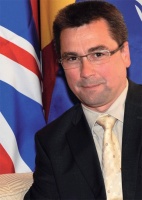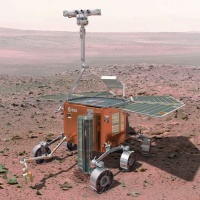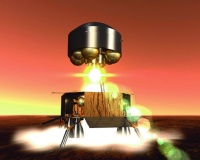
Harwell, near Oxford, is one of the UK’s premier hubs for science and technology. For many years the headquarters of the Atomic Energy Research Establishment, it’s now the home of the Science and Technology Facilities Council’s Rutherford Appleton Laboratory, the ISIS X-ray source and the Diamond synchrotron light source. It’s also now home to a new European Space Agency (ESA) research facility: the ESA UK Harwell Centre.
The centre is directed by Martin Ditter, a German rocketry engineer. He said: ’There’s enormous potential in the UK space sector, and we at ESA felt that we weren’t connected to it in an optimum fashion. We felt that by being here on-site, we would be able to build the connections we need to bring the competence that exists within the UK into ESA.’
Ditter cites the strength of the commercial space industry in the UK and the UK’s involvement in EADS Astrium as proof of the nation’s potential. ’You have a very strong industry in this region. We felt that in the more institutional sense, which is where ESA operates, we weren’t making the best of it. It’s a case of connecting to the existing space communities and the university research.’
Ditter believes that forming stronger connections to the UK will benefit ESA in terms of shaping its projects. ’We felt disconnected from the space community here, and we were conscious that a lot of the work being done here was relevant to the subjects that ESA covers or wants to cover. Our research is done on the basis of programme proposals, and they don’t come from ESA cooking them up in its own little corner, isolated from everything else. It’s a matter of connecting the community and trying to sense what the various groups of researchers would like ESA to do. Then we compile this information into a Europe-wide consolidated proposal and ask the member states to fund that. We felt that by being in Harwell, closer to the UK research and commercial space community, we could do better at bringing the UK’s interests and expertise into that process.’
Another reason for the UK location is that ESA is in awe of the entrepreneurial culture in UK science and technology — possibly the fruit of the increased activity of universities in spinning-out research companies over the past decade. This is not only a way to realise the commercial possibilities of space research, Ditter said, it also feeds back into the research. ’What we’re trying to do is both look for new ways to commercialise space science — that is, ways to reach the investment community — and to look for the areas and applications in the wider industrial context where there is potential for commercialisation. The process of identifying these new services and finding the new applications will invariably lead us to identify the gaps in our research coverage.

’For example, we’d come across cases where a user proposed to develop a service or a technology, but after evaluating the proposal we’d find that the technology isn’t mature enough to do the job. That pertains to our role as a research and development agency, and we might then be able to say that there’s customer demand in this particular area for a service that we hadn’t thought about, but there’s also demand in the same domain — we hope — from scientists. In that way, we widen the user base for space technologies and identify where we need to invest in the research, with targets both in space and in industry.’
The Harwell Centre’s research priorities are keyed into strengths within the UK space community. The Earth Observation/Climate Change unit will be particularly concerned with improving the integration of data obtained from Earth observation into simulated climate models, to improve the accuracy of predictions derived from the models. The UK’s ATSR (Along Track Scanning Radiometer) instruments — high-resolution infrared cameras carried aboard ESA Earth observation satellites — provide data on sea surface temperatures; the UK also has expertise in using computer graphics to visualise complex climatic data.
ESA is also planning on deploying the UK’s expertise in robotic space exploration. Ditter said: ’We have some heritage with the UK in robotics, with the Beagle 2 project that unfortunately crashed onto Mars, but the robotics onboard represented major innovations in miniaturisation and autonomy. We believe that if you look beyond space, there are a lot of applications, not strictly to do with robots but very much connected with autonomy; that’s very relevant for the wider engineering user base, for intelligent transport systems and for technology to help the elderly retain their independence.’
Another part of this is an area that ESA calls ’planetary protection’, which encompasses both protecting other planets from potential contaminants from Earth’s environment, and, for missions involving sample return, protecting Earth’s environment from contaminants on other planets. With Mars sample-return projects scheduled for the 2020s, this is an important consideration. The technology is related to clean-room techniques developed for the prevention of contamination in biomedical laboratories. Ditter said: ’It’s essential to the exploration programme, and the UK has considerable expertise in the field; it gives us a chance to build links with another industrial sector and bring them more closely into the space science community.’

Among the resources to be built at Harwell is a curation facility, which will initially be used to store samples from bodies that are lifeless, such as the moon, asteroids and interplanetary space. It will also house samples taken during the construction of spacecraft, to provide a record of potential contaminants from Earth. A Mars sample-return mission would require the construction of a dedicated facility, which the Harwell Centre will research and design.
The centre will also research power sources for space exploration, which are vital for missions where solar power will not be available. These will be based on the heat given off by radioactive elements; a technology that the US and Russia have both used in the past, but which is new to ESA.
There are two types of radioisotope technologies of interest to ESA: heating systems, to keep the electronics onboard a spacecraft warm enough to operate properly; and thermoelectric generators, which convert heat into electricity. Both use plutonium dioxide as their active element. Ditter said: ’We’re unearthing this expertise in the UK. It dates back a long way but it still exists, and it’s an important part of the robotic exploration portfolio.’
Human spaceflight research is a possibility for the Harwell portfolio, but Ditter is cautious about this. He said: ’It isn’t an area where the UK has been contributing thus far, although it does have an astronaut in the ESA training programme. We’d welcome UK involvement in the human space programme, but at the moment the question isn’t on the table.’
Martin Ditter Biography
Project manager
ESA Harwell Centre
Education
1984 Mechanical Engineering and Automation, Helmut Schmidt University, Hamburg
Military service
1979-1991 Including studies and a tour of duty in Paris European Procurement Office
Career
1991 Joined ESA in Noordwijk, involved in procurement for XMM-Newton project
1999 Worked on integrated project team developing European Geostationary Navigational Service
2006 Worked with European Commission on handover of EGNOS to the EC
2009 Took charge of development of ESA Harwell Centre
Interests
Married with three daughters, and is a keen runner
Q&A Space-ial awareness
What attracted ESA to the UK in business terms?
We want to improve our processes within ESA, particularly with respect to the integrated application programme, which creates new services built on space technology. There’s a business dynamic that we see as being particularly present in the UK more so than elsewhere — it’s the entrepreneurial spirit that we feel would help us rethink processes that we’ve run within ESA for the past three decades.
It’s surprising to hear you say that, as within the UK we often feel that we’re lacking in entrepreneurship
That’s equally surprising to me. The way you set up businesses here, from my perspective as an engineer, all seems particularly dynamic. It’s connected with the proximity of the City and access to venture capital, and the willingness to invest. If there is a gap in British entrepreneurship, it appears to be more connected to the way new businesses aren’t taken up by the British economy, and end up being sold to companies in the US and elsewhere.
Are there particular examples of the way you want to operate?
The Star Tiger project very much represents one of the ways of working that we want to adopt at Harwell. Star Tiger was a project at the Rutherford Appleton Laboratory aimed at reducing the development time for a critical space technology programme; it developed and built a terahertz imaging camera in four months. The technology was spun-out into a company called ThruVision, and the terahertz camera based on the developments has gone on to be used in passive full-body scanning at airports.
What do you think ESA can learn from this?
Developments such as this are built on opportunities in the technical domain, which is a matter of having the right people in the right place. We need to look at which of these ingredients — scientists and engineers, people who spot commercial opportunities, investors — we can reproduce locally. We need to look at the ways in which we develop technology, and probably at how we work in partnerships.
What do you see are the advantages of this approach?
In widening the user base of space technology, you raise the profile of space research and increase the return on investment — that much is obvious. Your science minister [Lord Drayson] has put such an emphasis on space science and the role it plays in the UK economy — that’s exactly the sort of climate that we want to be a part of.




Nanogenerator consumes CO2 to generate electricity
Whoopee, they've solved how to keep a light on but not a lot else.